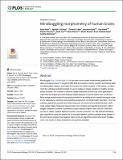Mindboggling morphometry of human brains
Author(s)
Klein, Arno; Bao, Forrest S.; Giard, Joachim; Stavsky, Eliezer; Lee, Noah; Rossa, Brian; Reuter, Martin; Chaibub Neto, Elias; Keshavan, Anisha; Hame, Yrjo; Ghosh, Satrajit S; ... Show more Show less
DownloadKlein-2017-Mindboggling morphometry of human b.pdf (8.883Mb)
PUBLISHER_CC
Publisher with Creative Commons License
Creative Commons Attribution
Terms of use
Metadata
Show full item recordAbstract
Mindboggle (http://mindboggle.info) is an open source brain morphometry platform that takes in preprocessed T1-weighted MRI data and outputs volume, surface, and tabular data containing label, feature, and shape information for further analysis. In this article, we document the software and demonstrate its use in studies of shape variation in healthy and diseased humans. The number of different shape measures and the size of the populations make this the largest and most detailed shape analysis of human brains ever conducted. Brain image morphometry shows great potential for providing much-needed biological markers for diagnosing, tracking, and predicting progression of mental health disorders. Very few software algorithms provide more than measures of volume and cortical thickness, while more subtle shape measures may provide more sensitive and specific biomarkers. Mindboggle computes a variety of (primarily surface-based) shapes: area, volume, thickness, curvature, depth, Laplace-Beltrami spectra, Zernike moments, etc. We evaluate Mindboggle’s algorithms using the largest set of manually labeled, publicly available brain images in the world and compare them against state-of-the-art algorithms where they exist. All data, code, and results of these evaluations are publicly available.
Date issued
2017-02Department
McGovern Institute for Brain Research at MITJournal
PLOS Computational Biology
Publisher
Public Library of Science
Citation
Klein, Arno; Ghosh, Satrajit S.; Bao, Forrest S.; Giard, Joachim; H?me, Yrj?; Stavsky, Eliezer; Lee, Noah et al. “Mindboggling Morphometry of Human Brains.” Edited by Dina Schneidman. PLOS Computational Biology 13, no. 2 (February 2017): e1005350 © 2017 Klein et al
Version: Final published version
ISSN
1553-7358
1553-734X